Looking for a 128 GB solid state drive (SSD) for your computer? Today we are going to compare the performance of seven different models from Corsair, Crucial, Kingston, Intel, Mushkin, Patriot and Western Digital. Which one you should buy? Check it out.
Before going on, we’d highly suggest you to read our Anatomy of SSD Units tutorial, which provides all background information you should know about SSDs. All units included in this round-up are based on MLC memory chips.
In the table below we compare the units we are going to review. All units use the 2.5″ form factor and SATA-300 interface. The unit from Kingston is available in three versions: “desktop bundle,” “notebook bundle” and “stand-alone.” We received the “desktop bundle” model, which comes with an adapter to allow you to install the unit on a 3.5” hard disk drive bay, a peripheral-to-SATA power adapter and a SATA cable. The unit from Patriot (Torqx) also comes with a 3.5”-to-2.5” adapter.
Intel X25-M is an oddball with its 160 GB capacity instead of 128 GB. This “strange” number happens because the controller chip used on this particular SSD divides memory in 10 channels, each channel having 16 GB (thus 10 x 16 GB = 160 GB). We decided to include this unit in our review because we think this model fits better with a 128 GB round-up than with a 64 GB or 256 GB round-up.
| Manufacturer | Model | Model # | Capacity | Price |
| Corsair | Nova Series | CSSD-V128GB2-BRKT | 128 GB | USD 369 |
| Crucial | CT128M225 | CT128M225 | 128 GB | USD 307 |
| Intel | X-25M | SSDSA2MH160G1C | 160 GB | USD 500 |
| Kingston | SSDNow V Series | SNV425-S2BD/128GB | 128 GB | USD 279 |
| Mushkin | Io | MKNSSDIO128GB | 128 GB | USD 379 |
| Patriot | Torqx | PFZ128GS25SSDR | 128 GB | USD 389 |
| Western Digital | SiliconEdge Blue | SSC-D0128SC-2100 | 128 GB | USD 400 |
Prices were researched at Newegg.com on the day we published this review, with the following observations:
- Crucial CT128M225 was out-of-stock. Its official list price at Newegg.com is USD 352 while the manufacturer suggested price is USD 400. We don’t know if Newegg.com will keep the huge discount when they restock this unit.
- Newegg.com offers a USD 25 mail-in rebate for Patriot Torqx, making this unit to cost USD 364 if you don’t forget to fill out the rebate card and ship it back.
- The price for the Kingston unit is for the “desktop budle” product, which comes with adapter for you to install it on a 3.5” hard disk drive bay. The stand-alone model (SNV425-S2/128GB) is sold by USD 260.
In the table below we provide a more in-depth technical overview of the reviewed units. For some reason most chip manufacturers don’t put on their websites specific information of these chips, so we are linking only what we found.
| Model | Controller | Buffer | Memory |
| Corsair Nova Series | Indilinx IDX110M00 | 64 MB (Elpida S51321DBH-6DTS-F) | Intel 29F64G08CAMDB |
| Crucial CT128M225 | Indilinx IDX110M00 | 64 MB (Elpida S51321DBH-6DTS-F) | Samsung K9HCG08U1M |
| Intel X-25M | Intel PC29AS21AA0 | 16 MB (Samsung K4S281632K-UC60) | Intel 29F64G08FAMCI |
| Kingston SSDNow V Series | Toshiba TC58NCF618GBT | 64 MB (Winbond W9751G61B-3) | Samsung K9HCG08U1M |
| Mushkin Io | Indilinx IDX110M00 | 64 MB (Hynix H55S5122DFR) | Samsung K9HCG08U5M |
| Patriot Torqx | Indilinx IDX110M00 | 64 MB (Elpida S51321DBH-5ATS-F) | Samsung K9HCG08U1M |
| Western Digital SiliconEdge Blue | Western Digital VAIL 1.07 (JMicron JMF612) | 64 MB (ESMT M14D5121632A) | Samsung K9HCG08U1M |
[nextpage title=”A Closer Look”]
Below we show you some pictures of the SSD units we included in our round-up.
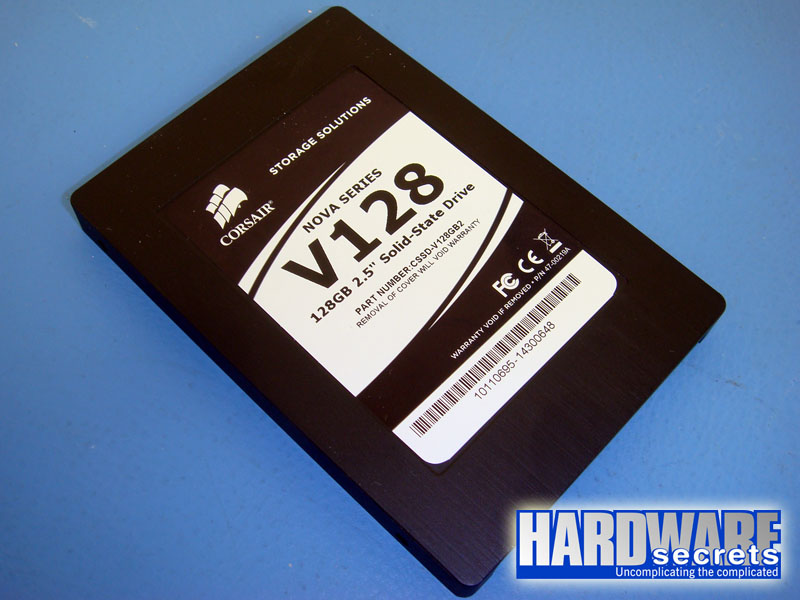
Figure 1: Corsair Nova Series 128 GB.
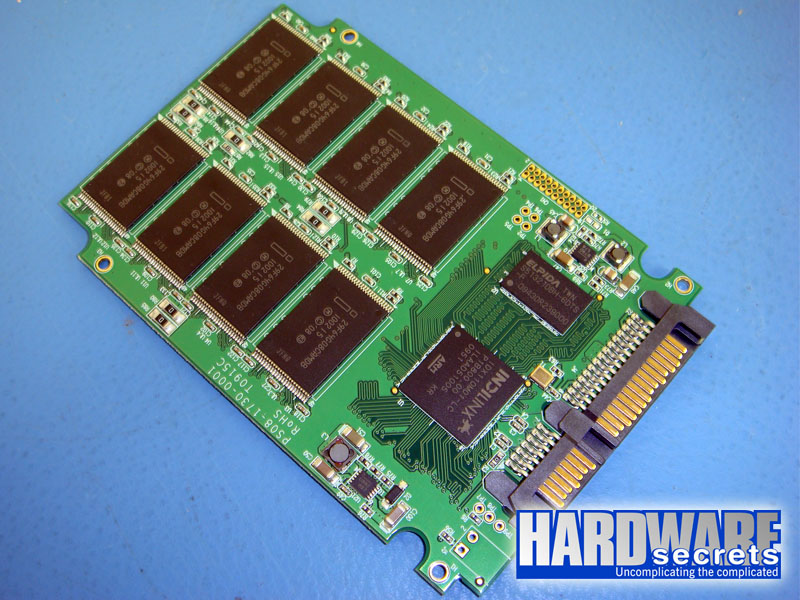
Figure 2: Inside Corsair Nova Series 128 GB.
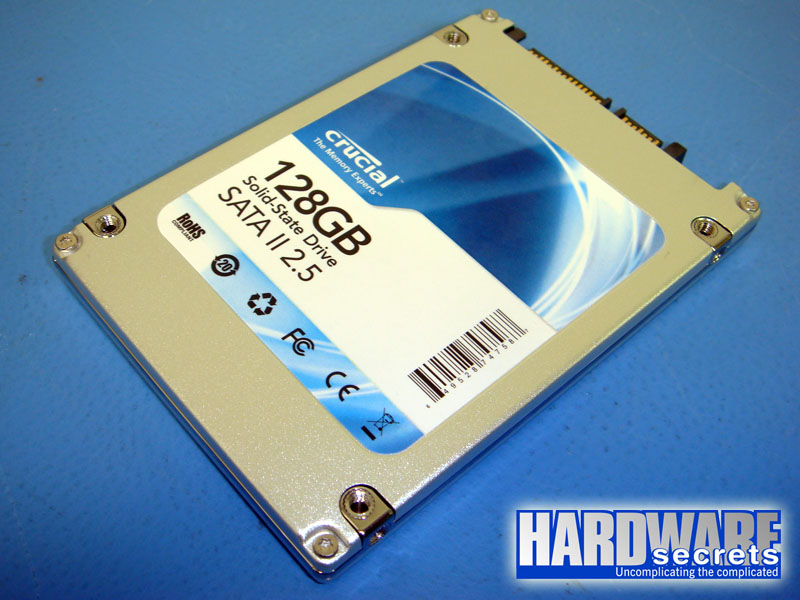
Figure 3: Crucial CT128M225.
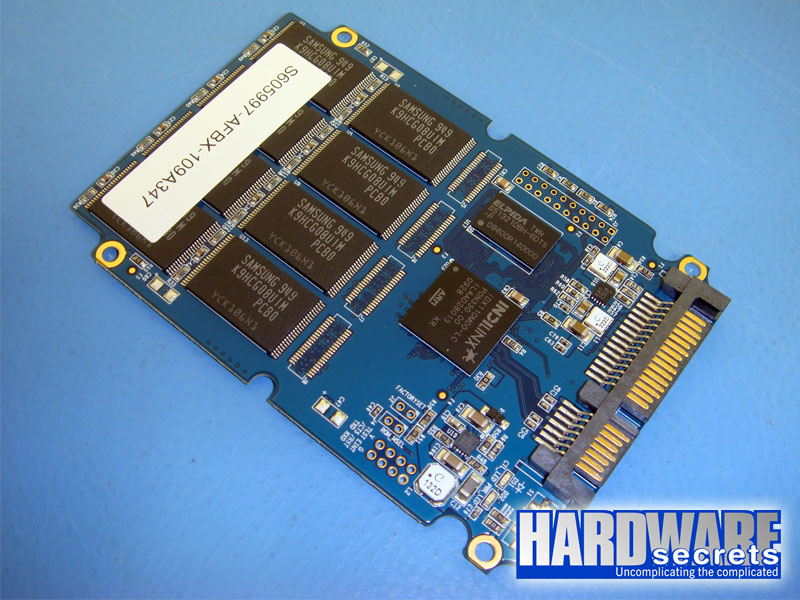
Figure 4: Inside Crucial CT128M225.
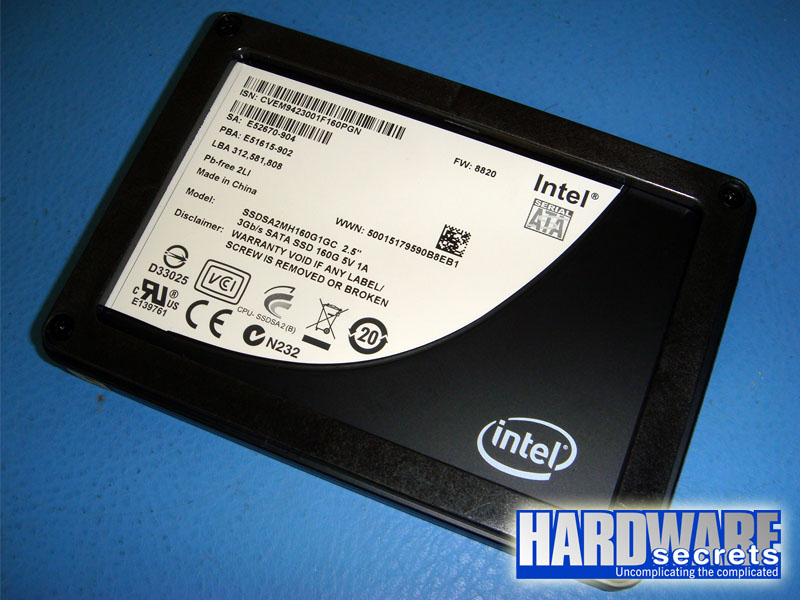
Figure 5: Intel X-25M 160 GB.

Figure 6: Inside Intel X-25M 160 GB.

Figure 7: Kingston SSDNow V Series SNV425-S2BD/128GB. Note the “desktop bundle” kit.
[nextpage title=”A Closer Look (Cont’d)”]
Below you can see the rest of the units we included in our round-up.
Figure 8: Inside Kingston SSDNow V Series SNV425-S2BD/128GB.
Figure 9: Mushkin Io 128 GB.
Figure 10: Inside Mushkin Io 128 GB.
Figure 11: Patriot Torqx 128 GB. Note the 3.5”-to-2.5” adapter.
Figure 12: Inside Patriot Torqx 128 GB.
Figure 13: Western Digital SiliconEdge Blue 128 GB.
Figure 14: Inside Western Digital SiliconEdge Blue 128 GB.
[nextpage title=”How We Tested”]
During our tests we used the configuration listed below and the only variable component between each benchmarking session was the SSD being tested.
Hardware Configuration
- CPU: Core i5-750
- Motherboard: ASUS P7P55D Premium
- Memory: Two 1 GB Crucial CT12864BA1339 modules (DDR3-1333/PC2-10600, CL9, 1.5 V), configured at 1,333 MHz
- Video Card: EVGA GeForce GTX 285 FTW
- Video resolution: 1440×900 75 Hz
- Video Monitor: Samsung Syncmaster 932BW
- Power Supply: SilverStone Element ST75EF 750 W
- CPU Cooler: Intel stock
- Hard Disk Drive (for booting): Seagate Barracuda 7200.10 160 GB
- Optical Drive: LG GSA-H54N
Software Configuration
- Windows 7 Ultimate 64-bit using NTFS file system
- Intel Inf driver version: 9.1.1.1020
- NVIDIA video driver version: 195.62
Benchmarking Software
Error Margin
We adopted a 3% error margin. So, performance differences below 3% cannot be considered meaningful. In other words, products where the performance difference is below 3% must be considered as having similar performance.
[nextpage title=”CrystalDiskMark”]
As you could see in the previous page, we measured performance using three different programs, CrystalDiskMark, DiskSpeed32 and HD Tune. On this page we will analyze the results provided by CrystalDiskMark, while in the next pages we will discuss the results brought by the other two programs.
It is important to note that we connected the SSDs to the motherboard SATA-600 port, to make sure performance wouldn’t be limited by the use of a SATA-300 port.
We left this program with its default configuration, meaning it benchmarked each SSD using five simultaneous threads using a file size of 100 MB. Let’s see the results.
On sequential read Intel X25-M and Corsair Nova achieved the same performance level, being the fastest units under this tests. They were around 6% faster than Western Digital SiliconEdge Blue and Kingston SSDNow V Series, 15% faster than Crucial CT128M255, 16% faster than Mushkin Io and 18% faster than Patriot Torqx.
As for sequential write, Corsair Nova continued being the fastest unit, while Intel X25-M dropped to be the worst unit. Here Western Digital SiliconEdge Blue, Mushkin Io, Patriot Torqx and Crucial CT128M255 achieved the same performance level and were, on average, 61% faster than Kingston SSDNow V Series and Intel X-25M. The performance from Corsair Nova was impressive: it was 28% faster than the units from the first group and 107% faster than the units from the second group.
On random read using 512 KB blocks, Western Digital SiliconEdge Blue was the fastest un
it, being 14% faster than Corsair Nova, 16% faster than Kingston SSDNow V Series, 28% faster than Intel X-25M and 36% faster than Patriot Torqx, Crucial CT128M255 and Mushkin Io.
On random write using 512 KB blocks Western Digital SiliconEdge Blue and Corsair Nova achieved the same performance level, being the fastest units. They were, on average, 18% faster than Patriot Torqx, Mushkin Io and Crucial CT128M255, 72% faster than Intel X-25M and 90% faster than Kingston SSDNow V Series.
On random read using very small blocks (4 KB), Corsair Nova was the fastest unit, being 25% faster than Mushkin Io, 27% faster than Crucial CT128M255 and Patriot Torqx, 53% faster than Intel X-25M, 93% faster than Western Digital SiliconEdge Blue and 140% faster than Kingston SSDNow V Series.
On random write using very small blocks (4 KB) Intel X-25M was the fastest unit, being 144% faster than Western Digital SiliconEdge Blue, 313% faster than Kingston SSDNow V Series, 340% faster than Patriot Torqx, 348% faster than Mushkin Io, 356% faster than Crucial CT128M255 and 555% faster than Corsair Nova.
[nextpage title=”DiskSpeed32″]
Let’s now see the results from DiskSpeed32, which measures performance on a different way, sequentially reading all sectors from the storage device.
First, let’s take a look at the burst transfer rate results. This result shows the maximum transfer rate between the SATA port on the motherboard and the controller inside the SSD.
Here Corsair Nova was the fastest drive, being 8% faster, on average, than Patriot Torqx, Crucial CT128M255 and Mushkin Io, 28% faster than Intel X-25M, 45% faster than Western Digital SiliconEdge Blue and 72% faster than Kingston SSDNow V Series.
But the most import result is the average transfer rate. Here the winner was Intel X-25M: it was, on average, 24% faster than Kingston SSDNow V Series and Western Digital SiliconEdge Blue, and 32% faster than Mushkin Io, Patriot Torqx, Crucial CT128M255 and Corsair Nova. The units from the first group were, on average, 6% faster than the units from the second group.
On the maximum transfer rate results, Intel X25-M was the fastest SSD, being 19% faster than Corsair Nova, 27% faster than Kingston SSDNow V Series and Wester Digital SiliconEdge Blue and 32% faster than Mushkin Io, Crucial CT128M255 and Patriot Torqx.
On the minimum transfer rate results, Intel X25-M achieved the best result, being 20% faster than Western Digital SiliconEdge Blue, 25% faster than Kingston SSDNow V Series, 37% faster than Corsair Nova and Patriot Torqx, 38% faster than Mushkin Io and 43% faster than Crucial CT128M255.
[nextpage title=”HD Tune”]
Now we have the results provided by HD Tune program.
On the burst transfer rate test, Patriot Torqx, Crucial CT128M255 and Mushkin Io achieved the same performance level. Corsair Nova was 20% faster than these three units, 28% faster than Intel X-25M, 98% faster than Western Digital SiliconEdge Blue and 212% faster than Kingston SSDNow V Series. It is always good to keep in mind that this is the maximum transfer rate between the drive and the motherboard and may not have any impact on the drive’s overall performance.
On the average transfer rate as measured by HD Tune, Intel X-25M was the fastest drive, being 12% faster than Corsair Nova, Crucial CT128M255, Patriot Torqx and Mushkin Io, on average, and 15% faster than Kingston SSDNow V Series and Western Digital SiliconEdge Blue, also on average.
On the maximum transfer rate as measured by HD Tach, Intel X-25M was again the fastest unit, with Corsair Nova achieving a performance almost on the same level. Intel X-25M was 11% faster than Crucial CT128M255, 12% faster than Mushkin Io, 13% faster than Patriot Torqx and 15% faster than Western Digital SiliconEdge Blue and Kingston SSDNow V Series.
And on the minimum transfer rate test Intel X-25M was again the winner, being 10% faster than Patriot Torqx, 12% faster than Mushkin Io and Kingston SSDNow V Series, 16% faster than Corsair Nova, 23% faster than Western Digital SiliconEdge Blue and 28% faster than Crucial CT128M255.
[nextpage title=”Access Time”]
Access time is another important measurement. It measures the time the storage unit delays to start delivering data after the computer has asked a given data. It is measured in the order of milliseconds (ms, which is equal to 0.001 s) and the lower this value, the better.
While hard disk drives have access times in the other of tens of milliseconds, solid state drives, being 100% electronic components, have an access time close to zero. All drives on both HD Tune and DiskSpeed32 achieved an access time of 0.1 ms.
[nextpage title=”Conclusions”]
So, which 128 GB solid state drive is the fastest? Well, it depends on the parameter you choose to look at.
For sequential read, the three programs we used confirmed Intel X-25M 160 GB as the fastest solid state drive under this kind of task. The other two drives that had great performance on sequential read were Corsair Nova 128 GB and Digital SiliconEdge Blue (both confirmed by two out of three programs to be the next choice after Intel’s unit).
Now for sequential write, Intel unit was the worst! This also happened with the 80 GB model. Under this particular test, Corsair Nova 128 GB and Western Digital SiliconEdge Blue 128 GB were the best-performing products.
Then we have random operations. For random reads using 512 KB blocks we have Western Digital SiliconEdge Blue 128 GB and Corsair Nova 128 GB again as winners, and when we reduced block size to 4 KB Corsair Nova 128 GB was the best-performing SSD, followed by Mushkin Io, Crucial CT128M255 and Patriot Torqx, which achieved the same performance level.
Now for random writes using 512 KB blocks we have Western Digital SiliconEdge Blue and Corsair Nova 128 GB tied in first place. When we reduced block size to 4 KB Intel X-25M 160 GB showed up as the fastest unit, followed by Western Digital SiliconEdge Blue 128 GB and Kingston SSDNow V Series 128 GB.
So, as you can see, Intel X-25M is really the fastest drive for sequential read operations – for all other kinds of operations (sequential writes, random reads and random writes), it loses to other products, in particular to Corsair Nova 128 GB and Western Digital SiliconEdge Blue 128 GB – except when writing random 4 KB blocks of data.
After this big summary, one big question remains: which 128 GB SSD unit should you buy?
Intel X-25M 160 GB is definitely an option if you are building a high-end PC and has a lot of money, but at USD 500 we don’t think it has the value the average user is looking for. If you are looking for performance, Western Digital SiliconEdge Blue 128 GB (USD 400) and Corsair Nova 128 GB (USD 369) are too terrific options with a better cost/benefit ratio for the normal user than the Intel unit, and we’d probably pick Corsair’s solution because it is always nice to save a little bit. This unit from Corsair is faster and cost less than Patriot Torqx (USD 389) and Mushkin Io (USD 379).
Now if you don’t have this kind of money, we have two units at the lower price spectrum: Crucial CT128M255 at USD 307 and Kingston SSDNow V Series 128 GB at only USD 279 for the “desktop bundle” kit (USD 259 for the stand-alone drive). Though not the fastest, both are interesting options because of their price. The unit from Kingston performed better than this unit from Crucial on most read tests, while the unit from Crucial was faster than the unit from Kingston on all write tests.






















Leave a Reply